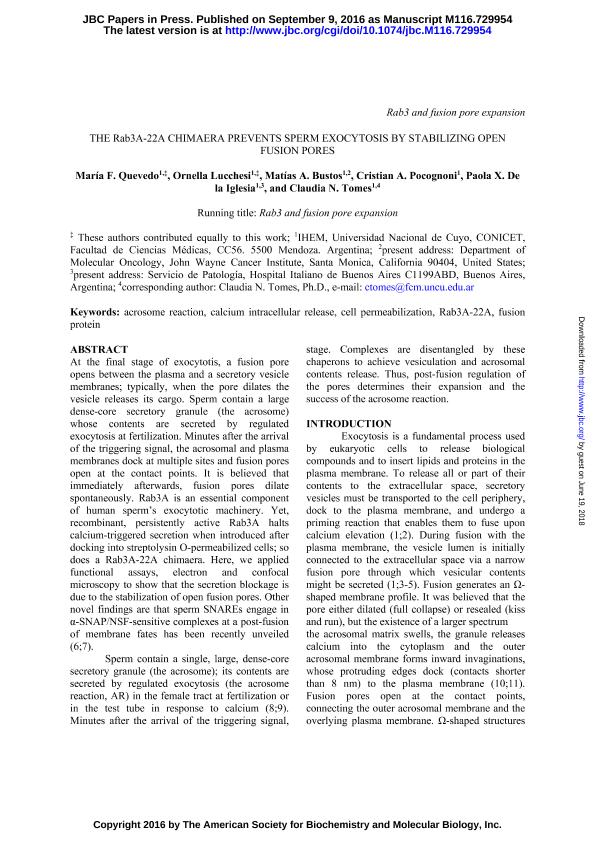Artículo
The rab3A-22A chimera prevents sperm exocytosis by stabilizing open fusion pores
Quevedo, María Florencia ; Lucchesi, Ornella
; Lucchesi, Ornella ; Bustos, Matias Alberto
; Bustos, Matias Alberto ; Pocognoni, Cristián Adrián
; Pocognoni, Cristián Adrián ; De la Iglesia, Paola X.; Tomes, Claudia Nora
; De la Iglesia, Paola X.; Tomes, Claudia Nora
 ; Lucchesi, Ornella
; Lucchesi, Ornella ; Bustos, Matias Alberto
; Bustos, Matias Alberto ; Pocognoni, Cristián Adrián
; Pocognoni, Cristián Adrián ; De la Iglesia, Paola X.; Tomes, Claudia Nora
; De la Iglesia, Paola X.; Tomes, Claudia Nora
Fecha de publicación:
10/2016
Editorial:
American Society for Biochemistry and Molecular Biology
Revista:
Journal of Biological Chemistry (online)
ISSN:
1083-351X
Idioma:
Inglés
Tipo de recurso:
Artículo publicado
Clasificación temática:
Resumen
At the final stage of exocytotis, a fusion pore opens between the plasma and a secretory vesicle membranes; typically, when the pore dilates the vesicle releases its cargo. Sperm contain a large dense-core secretory granule (the acrosome) whose contents are secreted by regulated exocytosis at fertilization. Minutes after the arrival of the triggering signal, the acrosomal and plasma membranes dock at multiple sites and fusion pores open at the contact points. It is believed that immediately afterward, fusion pores dilate spontaneously. Rab3A is an essential component of human sperm exocytotic machinery. Yet, recombinant, persistently active Rab3A halts calcium-triggered secretion when introduced after docking into streptolysin O-permeabilized cells; so does a Rab3A-22A chimera. Here, we applied functional assays, electron and confocal microscopy to show that the secretion blockage is due to the stabilization of open fusion pores. Other novel findings are that sperm SNAREs engage in α-SNAP/NSF-sensitive complexes at a post-fusion stage. Complexes are disentangled by these chaperons to achieve vesiculation and acrosomal contents release. Thus, post-fusion regulation of the pores determines their expansion and the success of the acrosome reaction.
Palabras clave:
Acrosome Reaction
,
Rab3a
,
Fusion Pore
,
Neurotoxin
Archivos asociados
Licencia
Identificadores
Colecciones
Articulos(IHEM)
Articulos de INST. HISTOLOGIA Y EMBRIOLOGIA DE MEND DR.M.BURGOS
Articulos de INST. HISTOLOGIA Y EMBRIOLOGIA DE MEND DR.M.BURGOS
Citación
Quevedo, María Florencia; Lucchesi, Ornella; Bustos, Matias Alberto; Pocognoni, Cristián Adrián; De la Iglesia, Paola X.; et al.; The rab3A-22A chimera prevents sperm exocytosis by stabilizing open fusion pores; American Society for Biochemistry and Molecular Biology; Journal of Biological Chemistry (online); 291; 44; 10-2016; 23101-23111
Compartir
Altmétricas



